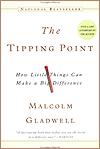“Listen, my children, and you shall hear” Our indelible school aged memories can, at least, complete the first stanza of Longfellow’s poem. Paul Revere’s midnight ride is perhaps the most famous historical example of a word-of-mouth epidemic. A piece of extraordinary news traveled a long distance in a very short time, mobilizing an entire region to arms and from that exchange came the American Revolution. Not all word-of-mouth epidemics are this sensational, of course. But, it is safe to say that word of mouth is – even in this age of mass communications and multimillion-dollar advertising campaigns – still the most important form of human communication. There are plenty of advertising executives who think that precisely because of the sheer ubiquity of marketing efforts these days, word-of-mouth appeals have become the only kind of persuasion that most of us respond to anymore. Perhaps this is the root cause of the tipping point of social media and web 2.0.
The Tipping Point is the biography of an idea. Ideas and products and messages and behaviors spread just like viruses do. Gladwell defines and examines epidemics and distills from his study three characteristics that explain epidemic transmission. These three characteristics-one, contagiousness, two, the fact that little causes can have big effects; and three, that change happens not gradually but at one dramatic moment- are the same three principles that define how measles move through a grade-school classroom or the flu attacks every winter. Of the three, the third trait-the idea that epidemics can rise or fall in one dramatic moment-is the most important, because it is this principle that makes sense of the first two and that permits the greatest insight into why modern change happens the way it does. The name given to that one dramatic moment in an epidemic when everything can change all at once is the Tipping Point.
Understanding the tipping point will allow us to answer simple questions that lie at the heart of what we would all like to accomplish as parents, marketers and business people. Why is it that some ideas or behaviors or products start epidemics and others don’t? What can we do to deliberately start and control positive epidemics of our own? Gladwell identifies three rules of The Tipping Point and labels them: The Law of the Few, the Stickiness Factor, and the Power of Context. These rules offer a way of making sense of epidemics and provide us with direction for how to go about reaching the Tipping Point. Gladwell takes these ideas and applies them to interesting and puzzling situations and epidemics that make the book a quick and interesting read.
The Law of the Few: A critical factor in epidemics is the nature of the messenger. The success of any kind of social epidemic is heavily dependent on the involvement of people with a rare set of social gifts; Connectors, Mavens, and Salesmen.
Connectors are people who have a truly extraordinary gift of making friends and acquaintances. Connectors are important for more than simply the number of people they know. Their importance is also a function of the kinds of people they know. The Connectors ability to span many different worlds is a function of something intrinsic to their personality, some combination of curiosity, self-confidence, sociability, and energy. They are people whom all of us can reach in only a few steps because, for one reason or another, they manage to occupy many different worlds and subcultures and niches. Connectors have many acquaintances that are weak ties but they represent a source of social power, and the more acquaintances you have the more powerful you are. Connectors are extraordinary powerful people that we rely on to give us access to opportunities and worlds to which we don’t belong.
Paul Revere was a Connector. After the Boston Tea Party in 1773, when the anger of the American colonists against their British rulers began to spill over, dozens of committees and congresses of angry colonists sprang up around New England. Paul Revere, a member of many of the groups, quickly emerged as a link between all these far flung revolutionary dots. Revere was described as gregarious and intensely social. He was a fisherman and a hunter, a card player and a theater-lover, a frequenter of pubs and a successful businessman. He was in the center of events. The newspaper accounts of his funeral said that troops of people were in attendance. Paul Revere was also a Maven.
Mavens. The word Maven comes from the Yiddish, and it means one who accumulates knowledge. The critical thing about Mavens is that they aren’t passive collectors of information. It isn’t just that they are obsessed with say how to get the best deal on a can of coffee. What sets them apart is that once they figure out how to get that deal, they want to tell you about it too. They are more than experts. An expert will talk about, say, cars because they love cars. A maven is more socially motivated. They will tell you all they know about cars because they love you and want to help you with your decision. Mavens are the kinds of people who are avid readers of Consumer Reports. Mavens have the knowledge and the social skills to start word-of-mouth epidemics. What sets Mavens apart, though in not so much what they know but how they pass it along. The fact that Mavens want to help, for no other reason than because they like to help, turns out to be an awfully effective way of getting someone’s attention. Mavens are not persuaders, they are data banks. They provide the message. Connectors are social glue: they spread it. But there is another select group of people.
Salesmen- have the skills to persuade us when we are unconvinced of what we are hearing, and they are as critical to the tipping point of word-of-mouth epidemics as the other two groups. Donald Moine, a behavioral psychologist who has written widely on the subject of persuasion, told Gladwell to interview Tom Gau, a financial planner in southern California. Gladwell describes Gau as possessing a natural exuberance. Gau is as likely to give you a hug or a kiss as shake your hand. Gau says, “I love my clients, okay? I’ll bend over backward for them.” “I call my clients my family. I tell my clients, I’ve got two families. I’ve got my wife and kids and I’ve got you.” Donald Moine and Gau put together a financial planner’s script book. Moine’s argument is that what separates a great salesman from an average one is the number and quality of answers they have to the objections commonly raised by potential clients. He sat down with Gau and tape-recorded all of Gau’s answers and wrote them up in a book. Moine and Gau calculate that there are about twenty questions or statements that a planner needs to be prepared for. What Gladwell notes though is that Gau seems to be persuasive in a way quite different from the content of his words. He seems to have some kind of indefinable trait, something powerful and contagious and irresistible that goes beyond what comes out of his mouth that makes people who meet him want to agree with him. It’s energy. It’s enthusiasm. It’s charm. It’s likeability. It’s all those things and yet something more.
The question of what makes someone-or something- persuasive is a lot less straightforward than it seems. We know it when we see it. But just what “it” is is not always obvious. The results of psychological studies indicate that little things can, apparently, make as much of a difference as big things. The findings show that non-verbal cues are as or more important than verbal cues and that persuasion often works in ways that we do not appreciate.
The Stickiness Factor: The messenger matters but the characteristics and content of the message matter too. The message must be memorable and move us to action. The message needs to be sticky to be successful and a small change is often all that it takes. We all want to believe that the key to making an impact on someone lies with the inherent quality of the ideas we present. But in none of the lengthy cases Gladwell studied, did anyone substantially alter the content of what they were saying. Instead, they tipped the message by tinkering, on the margin with the presentation of their ideas. There is a simple way to package information that, under the right circumstances, can make it irresistible. All you have to do is find it.
The Power of Context: We are more than just sensitive to changes in context. We’re exquisitely sensitive to them. And the kinds of contextual changes that are capable of tipping an epidemic are very different than we might ordinarily suspect.
How successful would Paul Revere’s ride be had he done it in the afternoon when people were out in the fields or out doing errands versus at night when people were at home in bed? When we are awakened in the middle of the night with news, it is generally urgent. Gladwell outlines studies that make the Power of Context argument very compelling. Violent crime declined gradually across the US in the 1990s for a number of straightforward reasons. The economy’s dramatic recovery provided jobs to those who might be lured into crime. The general aging of the population meant that there were fewer males between 18 and 24, the age range responsible for the majority of all violence.
In New York, however, the decline in violent crime was dramatic. Something else clearly played a role in reversing New York’s crime epidemic. One of the explanations is the “Broken Windows” Theory. Broken Windows was the brainchild of the criminologists James Q. Wilson and George Kelling. They argued that crime is the inevitable result of disorder. If a window is broken and left unrepaired, people walking by will conclude that no one cares and no one is in charge. Soon, more windows will be broken, and the sense of anarchy will spread from the building to the street on which if faces, sending a signal that anything goes. In a city, relatively minor problems like graffiti, public disorder, and aggressive panhandling, are all the equivalent of broken windows, invitations to more series crimes. The broken window theory was applied in the New York subways and over the course of a number of years, all the graffiti was cleaned up and the fare beating was brought to an end. Minor, seemingly insignificant quality-of-life crimes were the Tipping Points for violent crime. The Broken Window theory and the Power of Context are one and the same. They are both based on the premise that an epidemic can be reversed, can be tipped, by tinkering with the smallest details of the immediate environment.
The first lesson of the Tipping Point is that starting epidemics requires concentrating resources on a few key areas. The Law of the Few says that Connectors, Mavens, and Salesmen are responsible for starting word-of-mouth epidemics, which means that if you are interested in starting a word-of-mouth epidemic (i.e. referrals) your resources ought to be solely concentrated on those three groups. The second lesson of the Tipping Point is that those who are successful at creating social epidemics do not just do what they think is right. They deliberately test their intuitions. By tinkering with the presentation of information, we can significantly improve its stickiness. We are actually powerfully influenced by our surroundings, our immediate context, and the personalities of those around us.
By the way, at the same time that Revere began his ride north and west of Boston, a fellow revolutionary, a tanner named William Dawes, set out on the same urgent errand working his way to Lexington via the towns west of Boston. He was carrying the identical message, through just as many towns over just as many miles as Paul Revere. But Dawes’ ride didn’t set the countryside afire. If it were only the news itself that mattered in a word-of-mouth epidemic, Dawes would now be as famous as Paul Revere. Paul Revere was a Connector, a Maven. Dawes was ordinary man who, like many of us, once he left his hometown, probably didn’t know whose door to knock on.



